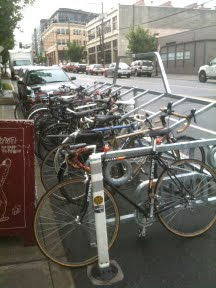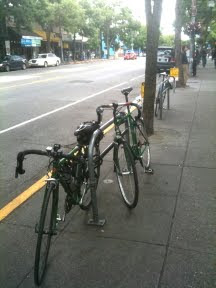A tragedy in Cheney and the “right” to drive
Why I Love the Bicycle Alliance
Nonprofits seem to operate in their own strange sphere in the world, some alternate reality that for-profit and governmental agencies remain almost entirely unaware of. It has taken me quite a while to figure out how to live in this parallel world; maybe the air is more rarefied, or the water a little bit purer, or the nutrients a bit more nutritious. Whatever the reason, I found myself slowly adapting to my new environment. Now, after 6 months with the Bicycle Alliance, I think I can quantify what I’ve come to appreciate about working there.
- Diversity. “What?” You may ask. “How can you say ‘diversity’ in an organization run almost entirely by white, middle-class baby-boomer women?” It’s true that if you take a superficial look at the Bicycle Alliance’s staff, it does seem to lack a certain breadth or depth. Yet each of the staff brings her (or his) own experiences to the organization and those contributions run the gamut. Name it and one of our staff people has probably done it.
Additionally, the diversity of people who walk in the door astounds me on a daily basis. I’ve started saying “You never know who’ll walk in,” and it’s true — working in Pioneer Square means interacting with everybody from homeless men to hot-shot tech people to everything in between. The vibrancy, the life, the variety of perspectives continually astound me.
- Passion. It’s quite true that people don’t work at nonprofits for the money. You have to truly care about the nonprofit’s mission in order to stay and succeed. At my old corporate job, we had no common bond, aside from “It pays the bills.” At the Bicycle Alliance, when we sit down for lunch together, we all have the shared love of bicycling drawing us together. Regardless of our differences, we all firmly believe in the importance and value of bicycles as a transportation option in the future, and we believe in making that a reality.
- Cool. I mean cool in the relaxed sense, the hakuna matata sense, the sense that although we’re all working hard to achieve important goals, we aren’t killing ourselves along the way. It means we’re taking time to go for a bike ride on a sunny day. It means that timing vacations just right isn’t really that important, but that having a relaxing time and coming back rejuvenated is. It means that I know if I wake up one morning and cannot drag myself in for love or money, that’s OK. Nobody’s going to flip a lid because I didn’t show up. It means that we’re having a favorite cinnamon roll contest and everybody will bring in a delicious offering. It means we can take time for personal concerns and not worry about an angry boss looking over our shoulders. It’s working to live, not living to work.
Those are just a few of the reasons I love the Bicycle Alliance. I’m not sure how I’ll go back to working a boring, cubicle-bound corporate job after my AmeriCorps tenure ends. Fortunately, I’ve learned another beautiful thing about nonprofits, which is summed up neatly in this exchange from Shakespeare in Love:
Philip Henslowe: Mr. Fennyman, allow me to explain about the theatre [my note: read “nonprofit” here] business. The natural condition is one of insurmountable obstacles on the road to imminent disaster.
Hugh Fennyman: So what do we do?
Philip Henslowe: Nothing. Strangely enough, it all turns out well.
Hugh Fennyman: How?
Philip Henslowe: I don’t know. It’s a mystery.
2011 Legislative Priorities
A big part of Washington Bikes’s mission is working in the State Legislature to make Washington state even more bike-friendly. Washington has been named the “most bike friendly state” three years in a row (the only state to ever be #1) by the League of American Bicyclists, but we all know there is more to be done to make our communities welcoming to everyone who might ride.
On June 12th, the Bicycle Alliance Legislative and Statewide Issues Committee met to set our priorities for the 2011 Legislative Session for recommendation to the full board. Committee members represent bike clubs and interests from around the state. We had at least nine counties and almost as many bike clubs represented. Many views and interests were expressed, but we came to agreement around:
Mutual Courtesy and Safe Passing Act. This bill would enhance the existing requirement for drivers to pass bicyclists safely and include other needed clarifications on bike-car interactions.
Share the Road bicycle and pedestrian education added to traffic school curriculum. This bill is modeled after the law the Bicycle Alliance got passed requiring all driver education schools in the state to teach a bicycle and pedestrian awareness curriculum.
Authorizing lower speed limits. By allowing cities and counties to adopt lower speed limits it would decrease bicyclist and pedestrian injuries and fatalities. Currently, lower limits can only be specified for school and construction zones.
Directional signs and bike maps are considered advisory. Motivated by Pierce County saying they’ll no longer publish a bike map due to a lawsuit by a cyclist injured while following a route, we want to protect both cyclists and the expansion cycling information and visibility.
Complete Streets grant program. Jurisdictions that have complete streets policies would be eligible to apply for state grant funding for implementation. This bill is another carryover from 2010, an effort led by Washington Bikes and Transportation Choices Coalition, among others.
Vulnerable Users. This would create an enhanced penalty if a pedestrian or cyclist (or other vulnerable roadway users) are killed or seriously injured by a motorist who violates a traffic law (such as failing to yield the right of way or speeding). Cascade Bicycle Club is the lead on this effort, and we are already working again to support it.
We’ll be keeping an eye out on the Safe Routes to School program making sure the community demand for grants and safe places to walk and bike is considered and that hopefully funding is increased when budgets and bills are written. The Bicycle Alliance will also work with other stakeholders to revise the Cost-Benefit law for transportation investments and a transportation funding package with significant investment in alternative transportation modes.
The Bicycle Alliance has a decades-long history of success in Olympia. The credit goes to our members and supporters who help give a bicyclists and potential bike riders a voice when laws are written.
Use this link to learn more about our priorities.
Teaching Safe Choices
I started to write a long post about bicycling safety. It included lots of statistics, facts, and figures. Ultimately, though, I found it very difficult to write about staying safe on a bike. When it comes to defining “safe,” you’ll get as many different definitions as people you ask.
Remember when your mom or dad taught you to ride a bike and told you “Only ride on the sidewalk”? Many adult bicyclists still adhere to that advice in the mistaken belief that it’s safer on sidewalks.
Remember how your running coach always told you to run against traffic so you could see cars coming? Adult cyclists want to see what’s coming, too, and ride the wrong way against traffic in a mistaken belief that’s safer than having cars approach from behind.
Remember how as a pedestrian you could, at opportune moments, ignore the signal and dash across the street real quick with no negative repercussions? Even more than pedestrians, bicyclists hate having to slow or stop, and many blatantly run stop lights (not to mention stop signs!).
People firmly believe that these activities really are safer.
My question (questions, really) for you, then, is this: How should we as informed bicyclists respond in these situations? A very few bicyclists engaging in dangerous and rude behavior makes bicycling less safe for all of us. Do we have a responsibility to educate misinformed bicyclists as we see them putting themselves in danger? Is there a way to do this effectively, without sounding like an obnoxious know-it-all? Is it possible to improve safety and enjoyment for bicyclists and motorists alike through on-the-spot education?
Or must we simply fall back on the truth that the only person you can control is yourself?
They’re on the Road
Yes, it’s been cold and wet this spring. Yes, it’s sometimes intimidating. Yes, it’s hilly in Seattle. But there’s lots of folks on the road. In the course of a couple of days I stopped at…
Hub and Spoke: Next Stop Vancouver
Washington Bikes continues to grow and nurture the seeds of bicycle advocacy in our state. In March, we launched our Hub and Spoke outreach tour in Wenatchee and over 50 cyclists joined us for a discussion of biking issues at the local, state and national levels.
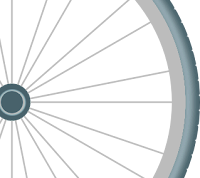 Tomorrow we take our Hub and Spoke tour to Vancouver, where critical cycling issues have hit the forefront. We’ll meet with members of BikeMe! Vancouver, Vancouver Bicycle Club and other area cyclists to discuss the bike issue du jour, elimination of funding for the City’s Bicycle Program, among other things.
Tomorrow we take our Hub and Spoke tour to Vancouver, where critical cycling issues have hit the forefront. We’ll meet with members of BikeMe! Vancouver, Vancouver Bicycle Club and other area cyclists to discuss the bike issue du jour, elimination of funding for the City’s Bicycle Program, among other things.
We also want to celebrate the cycling successes–and there have been successes. We want to thank Vancouver advocates who helped us pass the cell phone bill, which is now law. We want to hear about the new bike facilities that are in place. We want to talk about the progress that has been made with Safe Routes to School.
Please join us for this timely event if you live in Vancouver/Clark County. And please share this with others you know who care about the future of bicycling in this important region. Light appetizers will be provided. A no-host bar will be available.
Hub and Spoke: Vancouver
Thursday, June 24 at 5:30PM
Woody’s Tacos/Vancouver Marketplace
210 W Evergreen Blvd (corner of Columbia)
What Sir Isaac Newton Would Say to Washington’s Drivers, Lawmakers, and Traffic Engineers
 Funny thing about the laws of physics: You can study them, you can conduct experiments about them, and you can expand your understanding of them. But you can never, ever, break them.
Funny thing about the laws of physics: You can study them, you can conduct experiments about them, and you can expand your understanding of them. But you can never, ever, break them.
Biking is Sensual
 Biking is sensual. It stimulates my senses in a fashion that traveling by car cannot and immerses me in my environment.
Biking is sensual. It stimulates my senses in a fashion that traveling by car cannot and immerses me in my environment.
I am dazzled by the array of colors I see in rhododenrons, azaleas, and tulips in my neighborhood. The chalked hopscotch and foursquare boxes on the sidewalk amuse me. I make mental notes of upcoming yard sales and community events I see posted on the utility poles as I roll by. Sometimes I encounter a sunset so breathtaking, that I am compelled to pull my bike off the street to admire it.
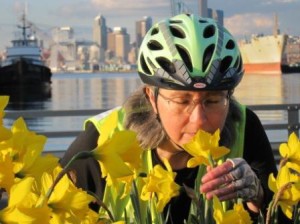 When biking to work on spring mornings, I become heady from the wafts of floral scents that my nose detects from lilacs, lavenders and other plants in bloom. I can smell the fishiness of the marine air and my stomach grumbles when I catch the yummy smells from nearby bakeries.
When biking to work on spring mornings, I become heady from the wafts of floral scents that my nose detects from lilacs, lavenders and other plants in bloom. I can smell the fishiness of the marine air and my stomach grumbles when I catch the yummy smells from nearby bakeries.
My ears catch so many sounds as I bicycle between home and work. Cooper, my neighbor’s dog, barks his greeting each morning as I pass through the alley. I eavesdrop on snippets of private conversation as I roll by the bus stop. The joyous laughter of children and their light footfalls reach my ears. I hear a ferry sound its foghorn in Elliott Bay.
It’s thrilling to feel the wind on my face as I coast downhill on my way to work. It’s comforting to feel the warm sun on my shoulders after days of riding with overcast skies. It’s refreshing to be splashed by water from lawn sprinklers and garden hoses as I ride by.
Sometimes, as I bike through my neighborhood, I catch a whiff of bacon so pronounced that I can taste it. I detect a salty flavor in the rain as it comes ashore from Puget Sound. I appreciate the refreshing glass of lemonade that I buy from the entrepreneurial kid who set up a lemonade stand on the corner.
Heightened senses are a key ingredient to my survival on the streets too.
My eyes constantly scan for movement and hazards around me. I track the cat on the sidewalk that might dart out in front of me. I anticipate the left turning motorist who crosses my line of travel. I’m on the lookout for potholes, glass and other street hazards that are a bane to cyclists.
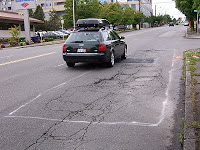 I listen for the sound of vehicles approaching from behind me, and I wish that passing cyclists would give me some sort of audible warning as well. I’m alert to the warning bark of dogs as they prepare to give chase. I’m bummed when I hear the hissing sound of air escaping from my tire as it goes flat.
I listen for the sound of vehicles approaching from behind me, and I wish that passing cyclists would give me some sort of audible warning as well. I’m alert to the warning bark of dogs as they prepare to give chase. I’m bummed when I hear the hissing sound of air escaping from my tire as it goes flat.
When I’m on a bike, I can feel the road. I experience the smoothness of blacktop and the pebbly rocks in chip seal. I am jarred by potholes and shaken to the bone by rumble strips. I feel the heat of the day rising from the pavement in the summer. I am buffeted by the wind created by a passing semi truck.
Yes, biking is sensual. It confirms that I am alive!


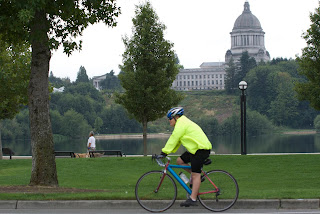

.jpg)

